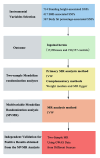Evaluating the relationship between standing height, body mass index, body fat percentage with risk of inguinal hernia: a Mendelian randomization study
- PMID: 39488648
- PMCID: PMC11531599
- DOI: 10.1038/s41598-024-78122-x
Evaluating the relationship between standing height, body mass index, body fat percentage with risk of inguinal hernia: a Mendelian randomization study
Abstract
Observational studies have suggested links between standing height, BMI, body fat percentage, and inguinal hernia risk, but with inconsistent results. We conducted Mendelian randomization (MR) method to investigate their causal relationships. Independent SNPs associated with standing height, BMI, and body fat percentage were extracted from GWAS data as instrumental variables (IVs). Two-sample MR initially explored causal relationships between these factors and inguinal hernia risk. Multivariable Mendelian randomization (MVMR) assessed the direct causal effects of exposures on inguinal hernia. Positive findings from the MVMR analysis were independently validated. The inverse-variance weighted Methods (IVW), weighted median(WM), and MR-Egger were used for the MR estimates. Sensitivity analyses were used to examine the stability and reliability of the results. Two-sample MR analysis revealed a suggestive causal association between height and inguinal hernia (OR = 1.091, 95% CI = 1.003-1.186, P = 0.042). BMI (OR = 0.846, 95% CI = 0.774-0.924, P < 0.001) and body fat percentage (OR = 0.793, 95% CI = 0.690-0.911, P = 0.001) were significantly protective factors. After MVMR adjustment, BMI (OR = 0.746,95%CI = 0.638-0.872, P < 0.001) remained protective. Independent validation yielded consistent result. Genetically predicted BMI is a significant protective factor for inguinal hernia, providing valuable guidance for individualized prevention strategies.
Keywords: BMI; Body fat percentage; Inguinal hernia; Mendelian randomization; SNP; Standing height.
© 2024. The Author(s).
Conflict of interest statement
The author(s) declared no potential conflicts of interest with respect to the research, authorship, and/or publication of this article.
Figures



Similar articles
-
The causal effect of adipose tissue on Hodgkin's lymphoma: two-sample Mendelian randomization study and validation.Front Immunol. 2024 May 30;15:1400756. doi: 10.3389/fimmu.2024.1400756. eCollection 2024. Front Immunol. 2024. PMID: 38873599 Free PMC article.
-
[Genetic Causation Analysis of Hyperandrogenemia Testing Indicators and Preeclampsia].Sichuan Da Xue Xue Bao Yi Xue Ban. 2024 May 20;55(3):566-573. doi: 10.12182/20240560106. Sichuan Da Xue Xue Bao Yi Xue Ban. 2024. PMID: 38948277 Free PMC article. Chinese.
-
Causation between the gut microbiota and inguinal hernia: a two-sample double-sided Mendelian randomization study.Sci Rep. 2024 Sep 4;14(1):20526. doi: 10.1038/s41598-024-71253-1. Sci Rep. 2024. PMID: 39227644 Free PMC article.
-
Causal association between body mass index and autoimmune thyroiditis: evidence from Mendelian randomization.Eur J Med Res. 2023 Nov 16;28(1):526. doi: 10.1186/s40001-023-01480-1. Eur J Med Res. 2023. PMID: 37974233 Free PMC article.
-
Causal effects of BMI, waist circumference, and body fat percentage on the risk of bladder cancer: A Mendelian randomization study.Medicine (Baltimore). 2024 May 17;103(20):e38231. doi: 10.1097/MD.0000000000038231. Medicine (Baltimore). 2024. PMID: 38758881 Free PMC article.
Cited by
-
Genome-wide lipidomic profiling reveals causal lipid species as targets for inguinal hernia risk.Mol Genet Genomics. 2025 Aug 21;300(1):78. doi: 10.1007/s00438-025-02284-0. Mol Genet Genomics. 2025. PMID: 40839010 Free PMC article.
-
Association between different obesity metrics and risk of inguinal hernia.Updates Surg. 2025 Apr;77(2):567-574. doi: 10.1007/s13304-025-02062-y. Epub 2025 Jan 16. Updates Surg. 2025. PMID: 39821601
-
Spatiotemporal trends in hernia disease burden and health workforce correlations in aging populations: a global analysis with projections to 2050.BMC Gastroenterol. 2025 Apr 25;25(1):296. doi: 10.1186/s12876-025-03916-w. BMC Gastroenterol. 2025. PMID: 40281398 Free PMC article.
-
Is the recurrence rate higher in obese patients undergoing inguinal hernia surgery?Hernia. 2025 Feb 26;29(1):107. doi: 10.1007/s10029-025-03301-2. Hernia. 2025. PMID: 40000506
-
Unveiling CTRB2, RSPO3, KLOTB, and ROR1 as obesity-pancreatic disease association proteins: a comprehensive Mendelian randomization study.Gastroenterol Rep (Oxf). 2025 Jul 31;13:goaf057. doi: 10.1093/gastro/goaf057. eCollection 2025. Gastroenterol Rep (Oxf). 2025. PMID: 40860620 Free PMC article.
References
-
- Primatesta, P. & Goldacre, M. J. Inguinal hernia repair: Incidence of elective and emergency surgery, readmission and mortality. Int. J. Epidemiol.25, 835–839 (1996). - PubMed
-
- Kingsnorth, A. N. & Leblanc, K. A. J. S. L. Management of Abdominal Hernias. 10.1007/978-1-84882-877-3 (2013).
-
- Everhart, J. et al. ed. Digestive Diseases in the United States: Epidemiology and Impact of Health and Human of of Diabetes and Digestive and Kidney Publication No (1994).
-
- Ruhl, C. E. & Everhart, J. E. Risk factors for inguinal hernia among adults in the US population. Am. J. Epidemiol.165, 1154–1161 (2007). - PubMed
MeSH terms
LinkOut - more resources
Full Text Sources

